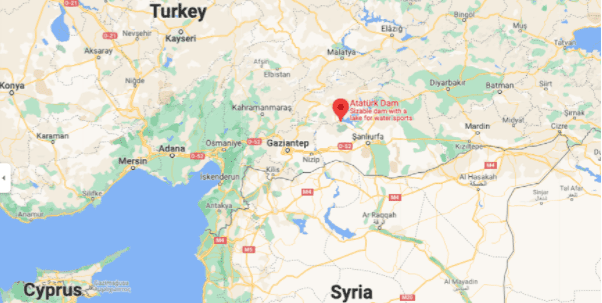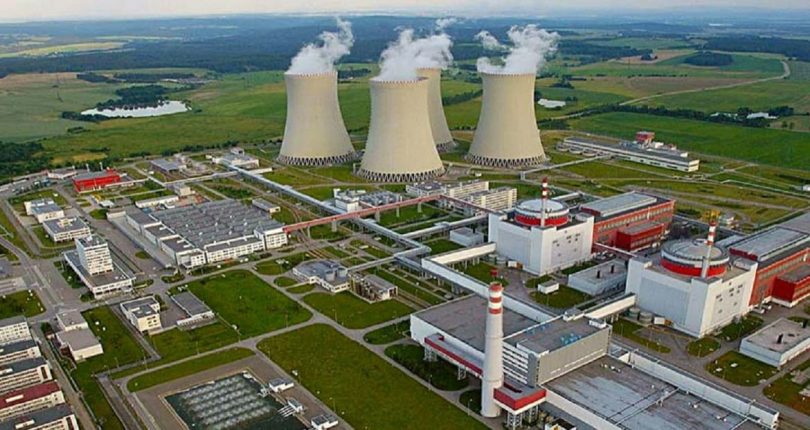The following fictional Red Cell scenario is intended to stimulate alternative thinking and challenge conventional wisdom, tying together events in operational fiction with national realities.
As Russian and Turkish nuclear engineers began the first powerup testing at the Russian-built Akkuyu Unit 1 Nuclear Power Plant, something was very wrong. In 2023, Russia suspended its construction activities at the Akkuyu Nuclear Power plant on the Turkish coast, north of Cyprus, in the wake of the Second Crimean War. Turkey was nearing a failed state with NATO demoting Turkey to observer status, and the civil war between nationalist and Islamic Turks was ravaging the country. Since the stake of Russia’s Rosatom State Corporation in the project was 99.2%, Russia has little to lose in finishing the project, so it thought. With Turkey out of NATO, not only was Russian President Putin successful in reducing NATO’s footprint, the 2022 standoff over Ukraine ended in a “negotiated stalemate”, Russia fought Turkey thirteen times in history; this time Russia won in Crimea. The United States (US) had more critical problems with massive civil disturbances associated with COVID-19 vaccinations.
First power-up criticality tests for nuclear power reactors are somewhat of an art rather than a textbook exercise. Computer simulation and heuristics are used as a guide but are not fully deterministic. It is like driving a car for the first time. A nuclear chain reaction occurs when uranium 235 absorbs a neutron, a subatomic particle that is a constituent of every element except ordinary hydrogen. After absorbing a neutron the uranium splits (fission) and makes two to three more neutrons. If the process of neutron generation is controlled, a steady state condition is created called power is generated from the heat created. A reactor’s condition can be critical, generating no power, or be at full power. Reactor operators, engineers, and computers collect and analyze many different data points as the control rods are lifted, exposing the nuclear fuel. Control rods absorb neutrons; the deeper the control rods are into the core, the more neutrons they absorb and vice versa.
Based on the design and architectural specifications of the Rosatom’s VVER 1200 Model V-509, used in the Akkuyu power station, initial near-criticality occurs when control rods are withdrawn about 50 cm from their fully inserted position. However, at 30 cm, some of the reactor fuel appeared critical or slightly higher while others were “cold.” None of this made sense, and worse, the entire nuclear fuel array has been irradiated, making it deathly radioactive. Refueling procedures would have to be used to pull all the fuel assemblies out and inspect each of them. For every day electricity is not being generated, the Akkuyu Nuclear Joint Stock Company pays other suppliers for the power it was contracted to generate. What was left of the Turkish civil press blamed competing power companies in Turkey for sabotage.
An intelligence-gathering department of Armenia’s National Security Services (NSS), with a non-descriptive name, “The Division,” determined that Turkey was planning on reprocessing Akkuyu’s spent nuclear fuel directly for a weapons program. Turkey’s humiliation on the world front, with rumors of Armenian and Kurdish (formerly Iraqi Kurdistan) nuclear weapons, and much of eastern Turkey in a battle between friend/foe nationalist and Islamic Turks fighting a massive Kurdish insurrection, Turkey’s Supreme Military Council concluded that what remained of Turkey, minus the east and southeast, needed to be defended to the last Turk. Azerbaijan, Turkey’s so-called brother state, was busy protecting its interests, having sent soldiers across much of Turkey to protect the BTC (Baku, Tbilisi, Cayhan) hydrocarbon transport pipeline. Much of its infrastructure was damaged by Kurdish insurrection.
In the meantime, secretly, spent fuel reprocessing capabilities were being built just west of Akkuyu. Turkish scientists were well aware of Armenia’s pyro-chemical spent fuel reprocessing success. The Turks were hacking into Armenia’s servers that supposedly had the operational plans for this state-of-the-art reprocessing technology. The Division had set up a series of servers used as bait with non-functional plans for Armenia’s pyro-chemical spent fuel separation technology. Having licensed this technology to the Japanese and South Koreans, the Armenians included fake pyro-chemical separation plans to trick hackers into thinking they had successfully stolen accurate plans. Japan and South Korea set up a sophisticated computer infrastructure, further obfuscating these fake plans. Something similar, targeting Iran with an inaccurate atom bomb design, was attempted some twenty years earlier.
Rosatom’s engineers poured over diagnostic data gathered from the initial power-on testing. They noticed that some of the software was not at the latest revisions, but they concluded this would still not account for any computational errors. The engineers subsequently tried a very conservative power up using manual instrument readings of neutron levels and heat across the core. The Russians even brought in old analog hardware instrumentation proven to work on all previous VVER reactors. Indeed something was wrong with the fuel assemblies. It would take months to replace all the fuel with new fuel. Not only were the Turks losing money, but Russians as well.
The Russian FSB immediately began investigating what initially looked like an embarrassing quality control issue. Special effort was made to isolate and remove a single suspected faulty fuel assembly. After several months of analysis, indeed, a series of apparently random 20% enriched uranium-235 fuel pellets were identified as having been part of at least that sample fuel assembly. The presence of 20% percent enriched uranium anywhere is not an accident. If indeed the plant’s reactor engineers ignored what their instruments and computer analysis were saying, there would be a catastrophic failure of the reactor during the initial powerup, considering that no reactor simulations exist for non-homogeneous fuel in commercial power reactors. There were several other investigations begun by the FSB. Where did the 20% enriched uranium come from? Who made them into pellets of the exact VVER size, and how did the pellets make their way into the fuel assemblies?
While the intense FSB investigations were ongoing, a new set of fuel assemblies were hand-assembled, with each pellet inspected with a solid paper trail. This process took months, as did the removal of all the fuel assemblies at the Akkuyu site. After six months and the loss of nearly a quarter billion dollars of revenue, the Akkuyu-1 plant was ready for its “second initial” power-up criticality tests. This second power-up was performed manually with analog computers and the plant’s real-time computer performing millions of calculations per second with a program modified to input more sensor data. A series of analog sensors developed at Armenia’s Mergelyan Institute of Mathematical Machines in the late 1980s were modified with up-to-date sensor material, using software libraries developed jointly between Rosatom and the Armenian conglomerate that purchased Armenia’s Metsamor nuclear power facility.
The Division knew that what remained of Turkey after the Second Crimean War was firmly determined to develop nuclear weapons, considering Turkey was not part of core NATO. Armenia gained a massive boost in international respect after Metsamor’s Spent Fuel Heist. Many of the major established international intelligence agencies courted Armenian’s diplomatic corps and intelligence infrastructure, which covertly used its diaspora’s unique capabilities. Turkey going rogue nuclear will never be allowed by those powers setting the world agenda. Turkey’s designs needed to be stopped, but NATO also desired to maximize Russian losses in nuclear power technology both financially and marketwise. Rosatom had many power plants under construction worldwide, and a nuclear catastrophe outside of Russia would kill Rosatom’s international presence – nobody would want a nuclear power station based on Russian technology. Turkey’s revanchist military laments the loss of control over much of its eastern provinces, southern borders, and what appears to be a nuclear Kurdistan, formerly Iraqi Kurdistan, is destabilizing the Turkish state. What remains of Turkey looks like what was demarcated in the 1920 Treaty of Sevres. At a minimum, it would take Turkish experts several years of reprocessing to have enough fissionable material for a weapon, even if they used the Armenian pyro-chemical reprocessing technology. The Turkish military was doing its best to gather reprocessing technology from North Korea, Pakistan, and its homegrown nuclear and chemical scientists. Having hacked into Armenian, Japanese, and South Korean fake pyro-chemical reprocessing technologies, it was decided it would take too long to determine how much of these various technologies were real; after all Turkish scientists and engineers were no fools. NATO and other western powers let the Turks waste time, effort, and resources constructing traditional reprocessing facilities.
Everything was checked and double-checked before the “second initial” Akkuyu-1 power-up began. Part of the checklist included feeding sample dangerous data into analog and digital computers and the main control room panel, to ensure the integrity of the start-up process. As much effort was put into this restart as was the launch of an orbital mission from Russia’s Cosmodrome in Kazakhstan. The restart commenced with the reactor operators raising the control rod at a click at a time with a modified joystick that could raise the control rods not only by groups but individual fuel assemblies as well. Ten cm, twenty cm — the core was heating up, and the water pumps were running normally. The neutron flux maps looked normal. By thirty centimeters, power would start rising from zero, increasing to 10 kW, 100 kW, 1 MW, to 10 MW. The on-sight Rosatom and Akkuyu Nuclear Joint Stock Company accountants were jubilant, and after so many problems, profits would now flow. After several hours of testing, the steam turbines and electrical systems associated with the dynamos (power plant alternators) looked good. Both computer systems agreed, and all the numbers looked well within range in the control room. However, the plant was not at full power, 3200 MW, which would happen after a few more days of operational testing at 2500 MW. Finally, the plant went to pull power, and all was running normally.
Several regional powers were pushing for the consolidation of Kurdish-controlled provinces in eastern Turkey with the new Kurdistan. One of the adventures the Kurds hadn’t engaged in was the destruction of utility infrastructures. The main reason being that Turkish Kurds would incessantly squabble amongst themselves in the eastern Turkish provinces, retaining much of their tribal social structures. Israel’s investment in establishing Kurdistan was substantial. Reducing any belligerent-to-Israel Arab state into its non-Arab constituencies has always been a goal of Israel. A strong Kurdistan would fulfill much of David Ben-Gurion’s Periphery Philosophy — make friends with states on the periphery of the Arab Middle East. A classic implementation of that plan was Israeli relations with Azerbaijan, but that relationship outlived its usefulness as Iran was no longer a threat to Israel and Arabs selling oil to Israel trumped support for Palestinians.
The target was the Ataturk Dam and hydroelectric infrastructure between Malatia and Gaziantep, the third-largest dam in the world. The Turks used this dam to affect policies in Syria by restricting water along the Euphrates River. When major contributors to a power grid go offline, the first thing that traditionally happens is to take nuclear plants offline as a precaution. Many other non-nuclear power stations disconnect when a significant contributor to the electrical power system unexpectedly goes offline. Rather than going offline, those operating plants would have to supply the existing demand, way beyond their generating capabilities, damaging mainly the electrical side of the power plant. It is for this reason widespread power blackouts do occur.

The most effective way to take out the Ataturk Dam is to strike it with multiple US GBU-72 Bunker Buster Bombs created for the US and Israel to take out Iranian underground nuclear facilities. The thought to use several low-yield nuclear weapons was dismissed as radioactive contamination would flow down the Euphrates river for hundreds of miles. Israeli stealth aircraft took out the Ataturk dam, which was more like a routine training mission since Israeli pilots used to use Turkey’s eastern and southeastern areas for training when relations were good between the two states.
When Ataturk was taken out, warning lights in Akkuyu’s control room lit up, but those lit up made no logical sense together. The reactor operators expected the plant to go electrically offline and for the reactor to shut down automatically. Within five seconds, the Akkuyu’s turbine began rumbling terribly. It felt like a severe earthquake when the turbine froze, unable by itself to supply most of Turkey’s electrical demand since most of Turkey’s other electric power stations were taken offline. The turbine stopped in its tracks. True to Newton’s Laws of Motion, the turbine shaft with its blades launched through the turbine housing and the steel-reinforced turbine building wall. The warning lights in the control room lit up like a Christmas tree, as the reactor was not automatically shutting down while thousands of cubic meters per second of superheated steam was escaping from the destroyed turbine housing. Eventually, the reactor shut down with much of its core melted.
The reactor operators noticed that the modifications made by Rosatom to monitor more data points in the reactor heat and neutron flux were not flashing. Subsequently, the FSB discovered that the changes made to the old sensors by Armenia’s Mergelyan Institute were sabotaged and deliberately made not to record a quick increase in temperature. This condition fooled the automatic reactor shutdown system and the injection of reserve cooling water and faked out the analog, digital computers, and the reactor operators in the control room, but not before a partial meltdown.
The prevailing winds were blowing north and northwest, dragging with it radioactive contamination. Time would tell the extent of how widespread the contamination was. The Akkuyu disaster served its purpose, although not anywhere near as bad as Chernobyl.
Rosatom was virtually bankrupt. Civil order in Turkey was anarchic. Greek troops occupied the European corner of Turkey from Edirne to Western Istanbul, renaming the latter Constantinople. The Greek Navy secured the Sea of Marmara, the Bosporus, and Dardanelles.
The Kremlin pulled every FSB resource to investigate the Akkuyu disaster. Who placed the 20% enriched uranium in the fuel assemblies was never discovered. However, in the 1950s, such fuel existed in both the US and the Soviet Union, used in experimental reactors. The Russian FSB concluded the placement of the 20% enriched uranium was a diversion allowing the Mergelyan Institute’s sensors to be installed in the VVER reactor. No records show that these so-called new sensors were upgraded. Instead, they were proven to be sensors designed for the older VVER-440 reactors (such as those at Armenia’s Metsamor nuclear power plant), yet somehow they made their way into the VVER-509. Several engineering managers at Rosatom ended up in jail. The KGB concluded that the control room control panel software and the automatic reactor shutdown software were hacked or somehow modified ever so slightly to accept the VVER-440 sensors. How this happened was not immediately known. It took months to identify this, but it could only have been done by individuals who developed the sensor. Yet the developers died in the 1990s.
Armenians made no secret that they could shut down Turkey’s electrical grid. They gained this knowledge as a requirement in order to shut down parts of Nakhichevan’s electrical power system (synced to the Turkish electrical grid) when Metsamor’s spent fuel was transported into Iran and Iraqi Kurdistan. Armenian electrical power grid hackers made Akkuyu think there were no power grid issues after the Israelis bombed the Ataturk dam, directly contributing to this cascade of catastrophic events.
Yerevan, Armenia
Author: David Davidian (Lecturer at the American University of Armenia. He has spent over a decade in technical intelligence analysis at major high technology firms. He resides in Yerevan, Armenia).




